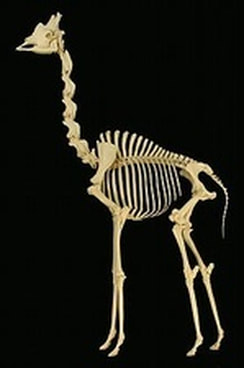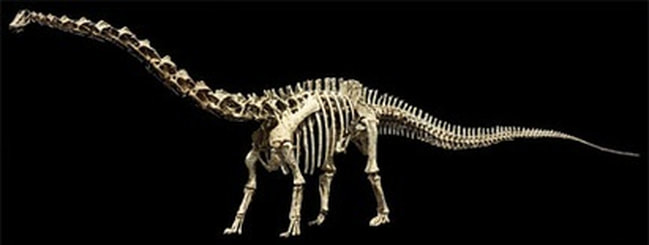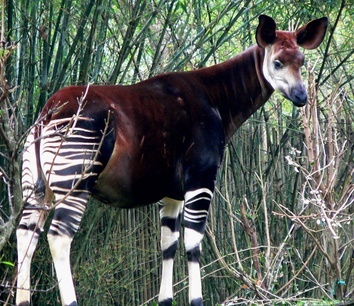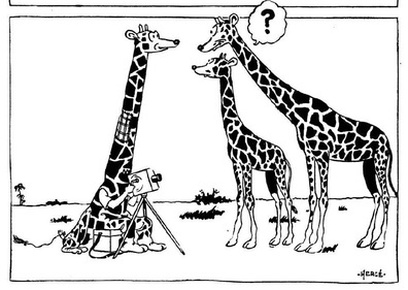This was a dumb thing inspired by a couple of high school friends who kept insisting to this one guy that giraffes weren't real, and he took them way too seriously and kept trying to prove them wrong. It still makes more sense than anything anti-vaxxers or creationists have to say.
The Giraffe Deception
By C. Randall Nicholson
Millions, probably billions, of innocent people are currently living out their lives under a delusion of the worst sort, a combination of innocent misconceptions and outright deceptions. They go about their lives clinging to a belief in the contemporary existence of an animal that has never walked this planet in any of its 4.6 billion year history. While there's room for speculation as to whether Sasquatches, Yetis or Loch Ness monsters share the Earth with us, the facts are quite definite on one point: the quadrupedal herbivore known as a "giraffe", though taken for granted by otherwise reasonable people who often dismiss the latter creatures, is no more real than the unicorn. Unfortunately, few people have been inclined to examine these facts for themselves.
I was devastated to learn the truth. One of my favorite books growing up was "A Giraffe and a Half" by Shel Silverstein. I still love it, but it wouldn't exist if not for the belief in this mythical creature. The giraffe delusion has brought joy and wonder to children and animal lovers everywhere, including my own little cousin who collects giraffe-themed toys, and I hate to take that away from them. But the truth has no agenda.
I was devastated to learn the truth. One of my favorite books growing up was "A Giraffe and a Half" by Shel Silverstein. I still love it, but it wouldn't exist if not for the belief in this mythical creature. The giraffe delusion has brought joy and wonder to children and animal lovers everywhere, including my own little cousin who collects giraffe-themed toys, and I hate to take that away from them. But the truth has no agenda.
An Innocent Mistake
It began as an innocent mistake. Giraffes have been "known" to the eastern world for millennia. However, this "knowledge" was most likely based on a merging of the characteristics belonging to leopards, real African ungulates such as zebras and gazelles, and some sort of sauropod dinosaur. Yes, you read that right. Rumors and sightings have long abounded of a large terrestrial/aquatic herbivore dwelling in the Congo River Basin, known as the mokele-mbembe ("one who stops the flow of rivers" in Lingala), the nsanga, or the chipekwe. Though descriptions vary, the overall image is that of a large sauropod dinosaur (long-necked dinosaurs such as Apatasaurus, Diplodocus, and Brachiosaurus).
Consider the implications. Though like all cryptozoological animals it is and may always be impossible to confidently say whether it exists and what, if so, it is, it is known among diverse tribes of diverse languages who are separated from each other by thick rainforest and as far as we know have had no contact with each other. When shown a series of pictures of non-African animals, they were clueless about most but identified a sauropod dinosaur as the mokele-mbembe. It would seem therefore that this animal cannot be dismissed off the bat and may provide a clue as to the origin of the giraffe legends. Since dinosaurs were unknown until the 1800s, a living specimen sighted before then wouldn't have been identified as such.
I don't mean to say that the mokele-mbembe itself is the basis for the giraffe. Obviously it lives in a different region of Africa and has never been described as being yellow with brown spots, but if one variety of sauropod dinosaur survived to the present day, others could have for a while as well. The reported sizes of giraffes, of course, is significantly smaller than that of most adult sauropods. However it's quite likely that whatever circumstances the "giraffe" species went through, which they survived and most dinosaurs didn't, removed the genetics for such large individuals. We see the same phenomenon today in several fish species when people catch and eat all the big ones.
This particular animal is almost certainly gone now. The savanna isn't like a rainforest where unknown species can escape human detection for decades, and of course many of the animals that live there now are endangered. This species may have been especially sensitive to human encroachment, perhaps only surviving in isolated pockets to begin with. Being hunted and captured by European and Asian explorers was probably more than it could take. True, the giraffe skeleton shown below has little in common with sauropods such as Diplodocus, but that's irrelevant because it's clearly a fake.
Consider the implications. Though like all cryptozoological animals it is and may always be impossible to confidently say whether it exists and what, if so, it is, it is known among diverse tribes of diverse languages who are separated from each other by thick rainforest and as far as we know have had no contact with each other. When shown a series of pictures of non-African animals, they were clueless about most but identified a sauropod dinosaur as the mokele-mbembe. It would seem therefore that this animal cannot be dismissed off the bat and may provide a clue as to the origin of the giraffe legends. Since dinosaurs were unknown until the 1800s, a living specimen sighted before then wouldn't have been identified as such.
I don't mean to say that the mokele-mbembe itself is the basis for the giraffe. Obviously it lives in a different region of Africa and has never been described as being yellow with brown spots, but if one variety of sauropod dinosaur survived to the present day, others could have for a while as well. The reported sizes of giraffes, of course, is significantly smaller than that of most adult sauropods. However it's quite likely that whatever circumstances the "giraffe" species went through, which they survived and most dinosaurs didn't, removed the genetics for such large individuals. We see the same phenomenon today in several fish species when people catch and eat all the big ones.
This particular animal is almost certainly gone now. The savanna isn't like a rainforest where unknown species can escape human detection for decades, and of course many of the animals that live there now are endangered. This species may have been especially sensitive to human encroachment, perhaps only surviving in isolated pockets to begin with. Being hunted and captured by European and Asian explorers was probably more than it could take. True, the giraffe skeleton shown below has little in common with sauropods such as Diplodocus, but that's irrelevant because it's clearly a fake.
It's easy to see how mankind's perception of this animal became conflated with that of so many other African herbivores so that, like the zebra, gazelle, wildebeest etc., people assumed it had hooves. Confusion over leopard coats persuaded them that it was a mammal with fur. People often equated the two creatures in their minds, as evidenced by the giraffe's archaic English name of camelopard (camel leopard) which is still manifest in the scientific name, Giraffa camelopardalis.
The knobby head things may have been an authentic part of the package; the result of some genetic mutation within the sixty-five million years since most dinosaurs died. Likewise the tail. A sauropod's tail is rather a distinctive feature and could hardly be mistaken for the decidedly stubby appendage that giraffes are "known" to sport. But this species was probably too slow to prevent small, agile lions and hyenas from chewing on its tail, and with the passage of time natural selection made it shorter. A change this drastic and brief (in evolutionary time) also helps explain why so few remained by the time humans found them.
The knobby head things may have been an authentic part of the package; the result of some genetic mutation within the sixty-five million years since most dinosaurs died. Likewise the tail. A sauropod's tail is rather a distinctive feature and could hardly be mistaken for the decidedly stubby appendage that giraffes are "known" to sport. But this species was probably too slow to prevent small, agile lions and hyenas from chewing on its tail, and with the passage of time natural selection made it shorter. A change this drastic and brief (in evolutionary time) also helps explain why so few remained by the time humans found them.
Rainforest Revelation
A more substantial clue (and an incredible stroke of luck for those perpetuating the legend) came with the discovery of the okapi, an antelope/zebra type of creature. Before it was made known to the world in 1901, Sir Harry Johnston, British governor of Uganda, managed to obtain the skull of one, which was similar enough to those which had been constructed for giraffes that this animal was classified as their relative. Okapis are also similar to giraffes in body shape, longer-than-average neck, and long flexible blue tongues with which they clean themselves. Perhaps the characteristics of the okapi were conflated in the first place with those of the leopard and the sauropod that the giraffe seems based on, but this seems unlikely because we're dealing with two entirely different environments and their human inhabitants were completely isolated from each other. But leopards also exist in the rainforest. It's likely that people migrating from the savanna into the rainforest encountered a leopard eating an okapi, thought the two were mating, and logically concluded that the offspring would be a giraffe.
Seeing is Believing
At this point you may be thinking, "Well, okay, but people do see giraffes on the savanna", or "I've seen a giraffe at the zoo" or something like that. Good for you. I've seen a couple of "giraffes" at the zoo myself. Majestic, awe-inspiring beasts. Too bad they're not real. This is where the deception comes in. Whether or not the idea of giraffes began as a case of mistaken identity, it is no longer. Take the fake skeleton in the picture above; someone's intentions were less than honorable when they built it. The governments of African nations, which were of course colonial and European at the time, realized that giraffes would be a key factor in attracting big-game hunters and other tourists.
But these very hunters and tourists would also prove the unraveling of the legend unless drastic action was taken. Thus it was that several native Africans were "enlisted" to devise and construct elaborate, life-size giraffe costumes and automatons. Any hunter who succeeded in shooting one would be brought into the conspiracy and sworn to secrecy under pain of death. Over the years, these automatons of necessity increased in sophistication, eventually being replaced by robots; in fact, they soon moved beyond the technological constraints known to the rest of the world. Experiments with holograms have also been undertaken in the last few decades but their success rate is unknown.
How do I know these things, you ask? Quite simply, on my trip to Spain, one of the African immigrant street vendors slipped my friends and me a folder containing several photographs of the automatons under construction, with a hastily written overview of what I've just described. The next thing I knew he was on the other side of the street, running, with police officers close behind. They hadn't seen him give it to me. I pored over the folder and vowed to share its contents with everyone I knew, but when I arrived home it had disappeared from my luggage. I have no doubt that airport security was involved. I don't know if the Spanish government has gotten involved in the plot or if it was just a few bribed authorities, but more importantly I don't know if the U.S. government is involved, and I don't know how long this page will be allowed to stay up.
But these very hunters and tourists would also prove the unraveling of the legend unless drastic action was taken. Thus it was that several native Africans were "enlisted" to devise and construct elaborate, life-size giraffe costumes and automatons. Any hunter who succeeded in shooting one would be brought into the conspiracy and sworn to secrecy under pain of death. Over the years, these automatons of necessity increased in sophistication, eventually being replaced by robots; in fact, they soon moved beyond the technological constraints known to the rest of the world. Experiments with holograms have also been undertaken in the last few decades but their success rate is unknown.
How do I know these things, you ask? Quite simply, on my trip to Spain, one of the African immigrant street vendors slipped my friends and me a folder containing several photographs of the automatons under construction, with a hastily written overview of what I've just described. The next thing I knew he was on the other side of the street, running, with police officers close behind. They hadn't seen him give it to me. I pored over the folder and vowed to share its contents with everyone I knew, but when I arrived home it had disappeared from my luggage. I have no doubt that airport security was involved. I don't know if the Spanish government has gotten involved in the plot or if it was just a few bribed authorities, but more importantly I don't know if the U.S. government is involved, and I don't know how long this page will be allowed to stay up.
A Pop Culture Reference
In this panel from Tintin in the Congo, Hergé may be wryly commenting on the issue, or it may be an ironic coincidence. It's hard to say. For most of his books he trawled far and wide for every tidbit of information he could get, and his personal files are something to behold. However, this was only the second Tintin adventure and he had not yet developed such extensive habits - his first, Tintin in the Land of the Soviets, was based almost solely on a pamphlet called "Moscou sans voiles" (Moscow Unveiled) and contained rather a few inaccuracies; and this one likewise appears to have been based on the literature of Christian missionaries. However because Hergé's native Belgium had control of the Congo at this time, he may have been acquainted with someone who knew of the giraffe deception.
If he learned of it, he wouldn't have mentioned it in the story, because its purpose (at the insistence of his boss) was to promote colonialism in the minds of Belgian youth, and it would have been a major turn-off for them to find out that one of the most famous and beloved animals in their country's biggest territory didn't exist. But he may, as I said, have commented on it in the above panel. It's interesting to note that these giraffes are practically the only wildlife in the story that Tintin doesn't kill, maim or torment. Why? Because there are "innocent" human beings inside them? One wonders, but one will never find out. In any case, it doesn't matter whether or not Hergé had this information. It only matters that now you do - so what are you going to do about it?
If he learned of it, he wouldn't have mentioned it in the story, because its purpose (at the insistence of his boss) was to promote colonialism in the minds of Belgian youth, and it would have been a major turn-off for them to find out that one of the most famous and beloved animals in their country's biggest territory didn't exist. But he may, as I said, have commented on it in the above panel. It's interesting to note that these giraffes are practically the only wildlife in the story that Tintin doesn't kill, maim or torment. Why? Because there are "innocent" human beings inside them? One wonders, but one will never find out. In any case, it doesn't matter whether or not Hergé had this information. It only matters that now you do - so what are you going to do about it?





